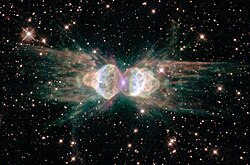Mz 3
| Nebula | |
|---|---|

The Ant Nebula
|
|
| Observation data: J2000 epoch | |
| Right ascension | 16h 17m 13.392s |
| Declination | −51° 59′ 10.31″ |
| Distance | ~8,000 ly (~2,500 pc) ly |
| Apparent magnitude (V) | 13.8 |
| Apparent dimensions (V) | >50″ × 12″ |
| Constellation | Norma |
| Physical characteristics | |
| Radius | 1.0 ly ly |
| Absolute magnitude (V) | 1.8 |
| Notable features | Three nested pairs of bipolar lobes |
| Designations |
ESO 225-9, Ant Nebula, |
ESO 225-9, Ant Nebula,
Mz 3 (Menzel 3) is a young bipolar planetary nebula in the constellation Norma that is composed of a bright core and four distinct high-velocity outflows that have been named lobes, columns, rays, and chakram. These nebulosities are described as: two spherical bipolar lobes, two outer large filamentary hour-glass shaped columns, two cone shaped rays, and a planar radially expanding, elliptically shaped chakram. Mz 3 is a complex system composed of three nested pairs of bipolar lobes and an equatorial ellipse. Its lobes all share the same axis of symmetry but each have very different morphologies and opening angles. It is an unusual PN in that it is believed, by some researchers, to contain a symbiotic binary at its center. One study suggests that the dense nebular gas at its center may have originated from a source different from that of its extended lobes. The working model to explain this hypothesizes that this PN is composed of a giant companion that caused a central dense gas region to form, and a white dwarf that provides ionizing photons for the PN.
Mz 3 is often referred to as the Ant Nebula because it resembles the head and thorax of a garden-variety ant.
Mz 3 is radially expanding at a rate of about 50 km/s and has its polar axis oriented at an angle of around 30° from the plane of the sky (Lopez & Meaburn 1983; Meaburn & Walsh 1985). It is sometimes compared to the more extensively studied Butterfly Nebula (M 2-9), and it is quite likely that both have a similar evolutionary history. They both have point-like bright nuclei, are narrow-waisted bipolar nebulae, and share surprisingly similar spatially dependent spectra. Because of their similarity, their differences are noteworthy. Their greatest difference is probably in their near infrared emissions. Mz 3 has no trace of molecular hydrogen emission, whereas the M 2-9 has prominent H2 emission lines in the near-IR. The lack of H2 emissions from Mz 3 is unusual given the strong correlation between such emissions and bipolar structures of PN. Additionally, the polar lobes of Mz 3 are more mottled and rounded as compared to M 2-9. Finally, Mz 3 is not known to evidence temporal variability in its polar lobes as is found in M 2-9 (Doyle et al. 2000). (Smith 2003)
...
Wikipedia
